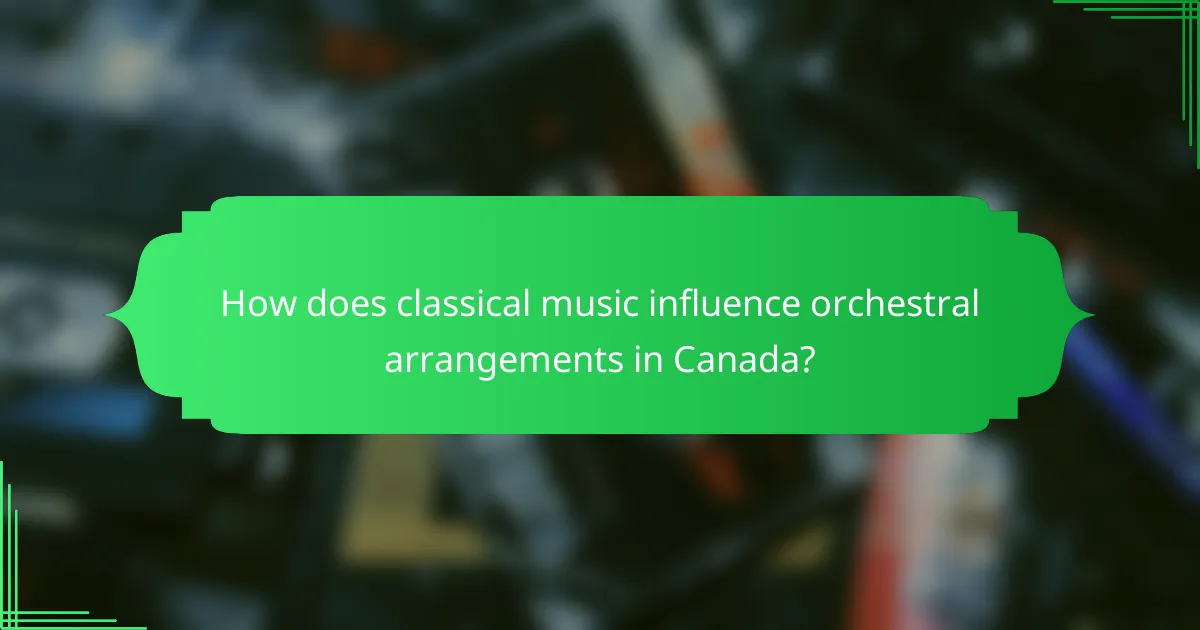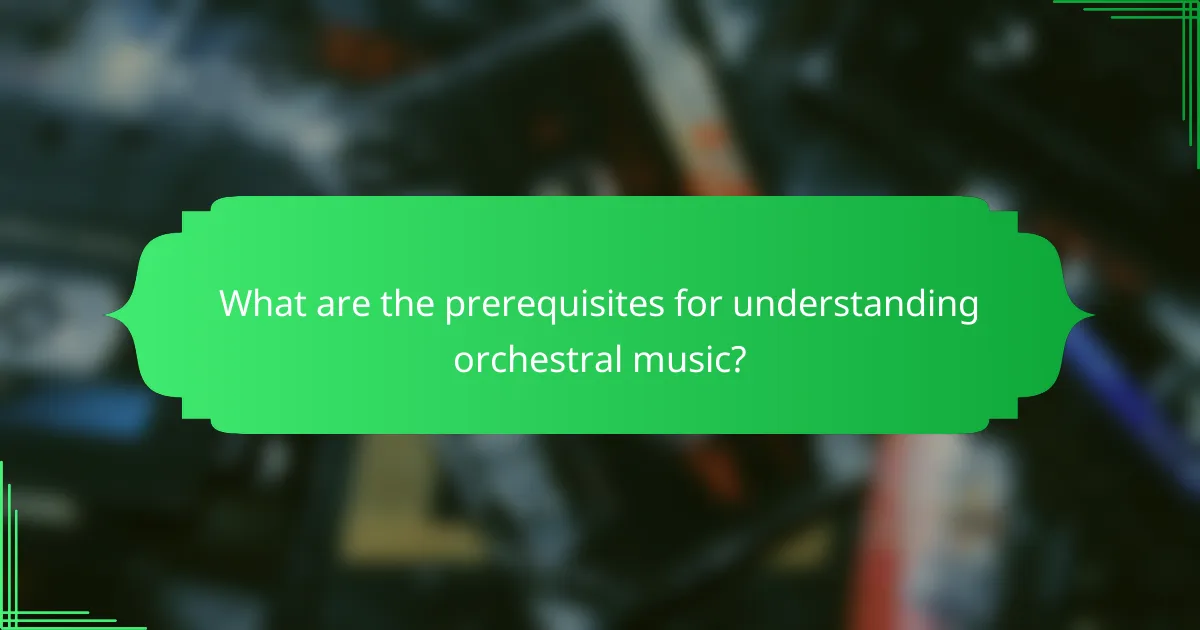Classical music plays a vital role in shaping orchestral arrangements, reflecting historical significance and cultural impact across various regions, including Canada. By blending traditional elements with innovative compositions, it creates rich, multi-layered soundscapes that resonate emotionally with audiences. The evolution of this genre, marked by the contributions of notable composers and the establishment of major orchestras, showcases its enduring relevance and diversity.

How does classical music influence orchestral arrangements in Canada?
Classical music significantly shapes orchestral arrangements in Canada by incorporating diverse cultural elements and fostering innovation. This influence manifests through the blending of traditional Canadian music with classical forms, enhancing the richness and variety of orchestral performances.
Integration of traditional Canadian folk elements
Orchestral arrangements in Canada often integrate traditional folk elements, creating a unique sound that reflects the nation’s cultural heritage. Composers draw inspiration from regional folk melodies and rhythms, weaving them into classical frameworks to produce a distinct auditory experience.
For instance, pieces may feature fiddle tunes or vocal styles characteristic of Canadian folk music, which enrich the orchestral texture. This integration not only honors Canadian traditions but also appeals to a broader audience by connecting classical music with familiar cultural references.
Collaboration with contemporary composers
Collaboration with contemporary composers is vital in shaping modern orchestral arrangements in Canada. These partnerships often result in innovative works that push the boundaries of traditional classical music, incorporating new styles and techniques.
Many Canadian orchestras actively commission new compositions, allowing contemporary voices to contribute to the orchestral repertoire. This practice not only revitalizes the classical music scene but also ensures that it remains relevant to current audiences.
Use of indigenous instruments
The use of indigenous instruments in orchestral arrangements adds a profound layer of cultural significance and authenticity. Composers are increasingly incorporating instruments such as the hand drum or the flute to create a soundscape that reflects Canada’s indigenous heritage.
This practice fosters a deeper connection between the music and the land, emphasizing the importance of indigenous narratives within the broader context of Canadian classical music. By blending these instruments with traditional orchestral elements, composers create a rich tapestry that honors both indigenous and classical traditions.

What are the historical milestones of classical music in Canada?
Classical music in Canada has evolved through several key milestones that reflect its rich cultural tapestry. Notable developments include the establishment of major orchestras, the influence of European immigrants, and the rise of Canadian composers, all contributing to a unique musical landscape.
Establishment of the Toronto Symphony Orchestra
The Toronto Symphony Orchestra (TSO), founded in 1922, marked a significant milestone in Canadian classical music history. It became a central institution for orchestral performance, showcasing both international and Canadian works. The TSO has played a crucial role in promoting classical music across Canada and has helped elevate the profile of local composers.
Over the decades, the TSO has collaborated with renowned conductors and soloists, enhancing its reputation. Its diverse programming includes classical masterpieces, contemporary works, and community outreach initiatives, making classical music accessible to a broader audience.
Influence of European immigration
European immigration significantly shaped the classical music scene in Canada, particularly in the late 19th and early 20th centuries. Immigrants brought their musical traditions, which blended with local influences to create a unique sound. This cultural exchange enriched the Canadian music landscape, fostering a vibrant community of musicians and composers.
Many European immigrants established music schools and orchestras, contributing to the development of classical music education in Canada. Their influence is evident in the works of early Canadian composers who incorporated European styles while infusing them with local elements.
Development of Canadian classical composers
The emergence of Canadian classical composers in the 20th century marked a pivotal moment in the country’s musical identity. Composers like Healey Willan and Claude Vivier began to gain recognition, creating works that reflected Canadian themes and experiences. This shift encouraged a greater appreciation for homegrown talent within the classical music community.
Today, Canadian composers continue to thrive, with a diverse range of styles and influences. Organizations such as the Canadian Music Centre support and promote these artists, ensuring that their contributions are celebrated both nationally and internationally.

How do orchestral arrangements enhance classical music experiences?
Orchestral arrangements significantly enhance classical music by creating rich, multi-layered soundscapes that engage listeners on various emotional levels. These arrangements utilize a diverse range of instruments, allowing composers to explore complex harmonies and textures that elevate the overall musical experience.
Layering of instrumental textures
The layering of instrumental textures in orchestral arrangements allows for a more intricate sound. Different sections of the orchestra, such as strings, woodwinds, brass, and percussion, contribute unique timbres that blend together to create a fuller auditory experience. For instance, a symphony may feature violins playing a melody while cellos provide a harmonic foundation, enriching the overall sound.
This layering can also highlight specific instruments or sections, drawing the listener’s attention to particular musical ideas. Composers often use this technique to evoke specific moods or themes, making the music more immersive and engaging.
Dynamic range and emotional expression
Orchestral arrangements offer a wide dynamic range, from soft, delicate passages to powerful, climactic moments. This variability allows composers to express a broad spectrum of emotions, enhancing the listener’s connection to the music. For example, a quiet, introspective section can lead into a dramatic crescendo, creating a sense of tension and release.
Additionally, the use of dynamics can influence how audiences perceive the emotional content of a piece. Composers often employ crescendos and decrescendos strategically to guide listeners through the emotional landscape of the music, making the experience more impactful.
Audience engagement through live performances
Live orchestral performances create a unique atmosphere that enhances the classical music experience. The visual spectacle of musicians playing together, combined with the immediacy of sound, draws audiences into the performance. This engagement is often heightened by the physical presence of the orchestra, which can evoke a strong emotional response from the audience.
Furthermore, live performances allow for spontaneous interpretations and interactions between the conductor and musicians, adding an element of unpredictability. This dynamic can create memorable moments that resonate with audiences, making each performance a distinct experience.

What are the key characteristics of orchestral arrangements?
Orchestral arrangements are defined by their use of a diverse range of instruments, structured forms, and intricate harmonic progressions. These characteristics contribute to the rich, layered sound that defines orchestral music, allowing for emotional depth and complexity.
Instrumentation diversity
Instrumentation diversity refers to the variety of instruments used in an orchestral arrangement, typically including strings, woodwinds, brass, and percussion. Each section contributes unique timbres and textures, creating a fuller sound. For example, strings provide warmth, while brass adds power and brightness.
When arranging for an orchestra, consider the balance between different sections to ensure that no single group overwhelms the others. A common practice is to use a larger string section compared to woodwinds and brass, which allows for a rich foundation while still highlighting individual instruments.
Form and structure
Form and structure in orchestral arrangements dictate how the music unfolds over time. Common forms include sonata, symphony, and concerto, each with specific characteristics that guide the development of themes and motifs. For instance, a sonata typically features an exposition, development, and recapitulation, providing a clear framework for the music.
Understanding the chosen form is crucial for effective orchestration. It helps in deciding how to introduce themes, build tension, and resolve musical ideas. Arrangers should be mindful of transitions between sections to maintain coherence and flow throughout the piece.
Harmonic complexity
Harmonic complexity in orchestral arrangements involves the use of rich chords and intricate progressions that enhance emotional expression. This complexity can range from simple triads to more elaborate extended chords, often incorporating dissonance to create tension that resolves into consonance.
When composing harmonies, consider the overall mood and character of the piece. Using chromaticism or modal interchange can add depth and interest. Additionally, be aware of voice leading to ensure smooth transitions between chords, which is essential for maintaining clarity in orchestral textures.

How does classical music impact cultural identity in Canada?
Classical music significantly shapes cultural identity in Canada by reflecting the nation’s diverse heritage and fostering a sense of community. Through various orchestral arrangements and performances, it highlights multicultural influences and promotes national pride.
Representation of multicultural influences
In Canada, classical music serves as a canvas for multicultural influences, showcasing the rich tapestry of its population. Composers from various backgrounds incorporate traditional elements from their cultures, creating unique orchestral works that resonate with diverse audiences.
For example, works by composers of Indigenous, Asian, and European descent often blend traditional melodies and rhythms with classical forms, enriching the overall musical landscape. This representation fosters a deeper understanding and appreciation of different cultures within the Canadian context.
Promotion of national pride through music festivals
Music festivals across Canada play a crucial role in promoting national pride through classical music. Events such as the Toronto Symphony Orchestra’s performances and the Vancouver Symphony Orchestra’s concerts celebrate Canadian composers and showcase the country’s musical talent.
These festivals not only highlight the achievements of Canadian musicians but also encourage community participation, creating a shared experience that strengthens cultural identity. Attendees often feel a sense of belonging and pride in their national heritage as they engage with the music.
Education and outreach programs
Education and outreach programs are vital in fostering a connection between classical music and cultural identity in Canada. Many orchestras and music organizations offer workshops and concerts aimed at schools and communities, making classical music accessible to a broader audience.
These initiatives often include interactive sessions that introduce participants to the history and significance of classical music, emphasizing its role in shaping cultural identity. By engaging younger generations, these programs help ensure the continued appreciation and relevance of classical music in Canadian society.

What are the prerequisites for understanding orchestral music?
To understand orchestral music, one should have a grasp of basic music theory, knowledge of classical music history, and developed listening skills. These elements provide a foundation for appreciating the complexities and nuances of orchestral arrangements.
Basic music theory knowledge
Basic music theory knowledge is essential for understanding orchestral music. Familiarity with concepts such as scales, chords, and rhythm helps listeners recognize patterns and structures within compositions. For example, knowing how major and minor scales differ can enhance the appreciation of emotional contrasts in orchestral pieces.
Additionally, understanding musical notation allows listeners to follow scores and recognize instrumentation. This knowledge can deepen the experience of attending live performances or listening to recordings, as it enables one to identify the roles of different instruments within the ensemble.
Familiarity with classical music history
Familiarity with classical music history enriches one’s understanding of orchestral music. Knowing the major composers, such as Beethoven, Mozart, and Tchaikovsky, and their contributions to the orchestral repertoire provides context for the music. Each era, from Baroque to Romantic, has distinct characteristics that influence orchestral compositions.
Understanding historical developments, such as the evolution of orchestral size and instrumentation, can also enhance appreciation. For instance, recognizing how the Romantic period expanded orchestral forces can help listeners grasp the grandeur of works from that time.
Listening skills development
Developing listening skills is crucial for a deeper understanding of orchestral music. Active listening involves focusing on the details of a piece, such as dynamics, timbre, and orchestration. This practice allows listeners to discern the interplay between different instruments and appreciate the overall texture of the music.
To improve listening skills, one can start by focusing on specific sections of a piece and identifying the instruments involved. Regularly attending concerts or listening to recordings while following along with scores can further enhance this skill. Engaging with music in this way fosters a more profound connection to orchestral works and their emotional impact.
